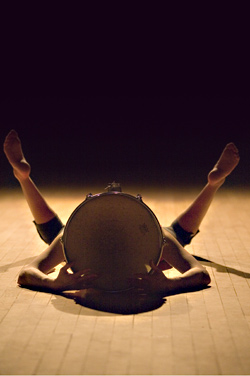In a dance field where the standard model is a group led by one charismatic individual, intent on fulfilling his or her particular artistic vision, d9 is an actual collective. The dancers pick the choreography, rehearse the works, crank out the press releases, and arrange the theater rentals. The result is a program that the dancers really love—what the audience thinks depends on how well their tastes match those of the inmates who run the asylum. “Pulp” was only a partial match for me.
Laura Curry likes to play on the difference (if there is one) between an audience member and a voyeur. In the past, she’s performed in shop windows and in replicas of peep-show booths. With 6 she’s co-opted Velocity’s ticket booth, set a performer on top of a storage cabinet, pulled open the back curtains, and sent someone out one window only to have them come back in another. But after she sets the stage, she cedes much of the content to others. Curry isn’t acting as a choreographer so much as an orchestrator or a compiler—the movement comes from the dancers; the sound score is a spoken-word mix of their journal entries. And while there are moments of beauty and strangeness—like Amie Baca measuring the confines of that storage cabinet by the length of her legs and the reach of her arms; or Jody Kuehner’s gawky walk as she strips off her funky black wig—there are also stretches of kinetic mumbling, where the phrases are short, the dynamic is even, and attention wanders easily. It could be that Curry intends it that way, taking a page from Merce Cunningham’s book and presenting us with the random nature of the world. But in a work where the hand of the artist is most distinct in the arrangement of the architecture, it’s hard to see the shape of the dance over time, so that the piece seems to stop rather than finish at the end.
Keith Johnson’s Outside Looking Up (Still)/Blue Print for a Goodbye has a much more intentional feeling—the little finger patterns and push-pull dynamics are crafted from a whole cloth. But the patchwork structure of the work—a series of vignettes and small sequences reinforced by a compiled score including eight composers—puts the onus on the audience again. One of the thrills of postmodern choreography, with its intense exploration of structural devices that refract and invert movement phrases, is figuring out the puzzle, finding the connections within the dance, and mapping it out, like a flow chart for a complicated computer program. It’s clear that the dancers revel in Johnson’s gestural details and shifting initiations, but so many of the phrases wind down into stillness, separated by moments of blackout, that we’re constantly restarting our observations, making it difficult to see a bigger picture.
Far from postmod, though, is Aliana Jaqua. She would have been a natural in the vaudeville world, with its combination of social commentary, silly walks, and popular dancing, all performed with a wink. The best parts of Jaqua’s Girls have that absurdist quality, particularly the mordant and manic cover of the Beastie Boys single—where Kuehner and Julietta Compagno Skoog chant the lyrics while Pamela Gregory and Laura Prudhomme accompany them on a snare drum and a child’s xylophone. As Kuehner and Skoog become hyperalert, Gregory and Prudhomme get increasingly glum, so that “I can always make them smile, from White Castle to the Nile” is a promise for the first pair and a prison sentence for the second. Gregory is particularly watchable, like a hangdog Audrey Hepburn with attitude—she’ll do whatever is on the bill, but she’ll let you know what she thinks about it.
Daniel Charon’s bio includes stints with José Limón and Doug Varone—choreographers who can make long, dancey phrases—so it’s natural that Charon’s The Present Time moves fluidly thorough space, accumulating momentum and spinning it out over the course of the work. The Lou Harrison score, with its droney, Middle Eastern accents, contributes to this, but the choreography doesn’t lean on the music so much as extend it. There’s a sweet and sleepy feeling to the floor work, like a 21st-century version of a Fredrick Leighton painting, but there’s tension between the dancers as well—the work opens with three couples, each shoving the other away. Charon makes the d9 women look like the smart dancers they are, and—this time, at least—lets the audience in on the process.








